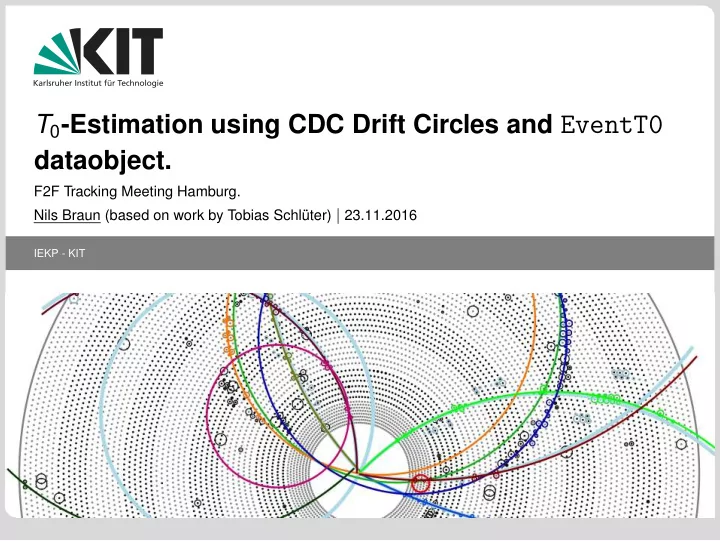

T 0 -Estimation using CDC Drift Circles and EventT0 dataobject. F2F Tracking Meeting Hamburg. uter) | 23.11.2016 Nils Braun (based on work by Tobias Schl¨ IEKP - KIT www.kit.edu
Motivation In the normal mode, we will have a bunch-Crossing every 2 ns. The CDC is read out (triggered) approx. every 30 ns and fed into the Level1 trigger. The global event time T 0 (the time of the bunch crossing this event was created in) has to be determined to a precision of approx. 2 ns, the rest is known from the accelerator system. Different possibilities to determine T 0 : TOP (very good time resolution, but needs tracks in TOP . Not present in Cosmics test). L1-Trigger (trigger jitter approx. 10 ns, 20 ns in worst case. Distribution?) CDC (Measuring drift circles is anyway a time measurement) T 0 -Estimation using CDC Drift Circles and EventT0 dataobject. - Nils Braun 23.11.2016 2/9
How does it work (taken from Tobias Schl¨ uter) What Does a Drift Chamber Measure? Measurement Procedure ▶ passing charged particle ionizes gas ▶ gas cloud collapses on wire ▶ difference 𝑈( passage of particle ) − 𝑈( collapse ) gives distance of passage How do we know the passage time? Usually: ▶ Starting time of the track is evaluated ▶ 𝑈( Passage ) = Track Length / Velocity A drift chamber is a device that measures time, positions are inferred. Tobias Schlüter December 17, 2015 Event Time from Tracks 2 / 11 T 0 -Estimation using CDC Drift Circles and EventT0 dataobject. - Nils Braun 23.11.2016 3/9
How does it work (taken from Tobias Schl¨ uter) What Happens if the Time is Badly Known? The simplest case, straight lines, all hits on one side. Correct Timing Passage Time Underestimated ▶ position measurement depends on the evaluated drift time ▶ In this simple case a bias in time leads to bias in position. Tobias Schlüter December 17, 2015 Event Time from Tracks 3 / 11 T 0 -Estimation using CDC Drift Circles and EventT0 dataobject. - Nils Braun 23.11.2016 3/9
𝑗 How does it work (taken from Tobias Schl¨ uter) Time Alignment Tracking problem: 𝜓 2 = (𝑛 𝑗 − 𝐼 𝑗 𝑡) 𝑈 𝑆 − 1 𝑗 (𝑛 𝑗 − 𝐼 𝑗 𝑡) = min hits i Minimize the distance between the measurements 𝑛 𝑗 and the projections 𝐼 𝑗 of the track parameters 𝑡 , i.e. the residuals 𝑠 , weighted by the residual covariances 𝑆 𝑗 = 𝑊 𝑗 − 𝐼 𝑗 𝐷𝐼 𝑈 ( 𝑊 𝑗 measurement covariance, 𝐷 covariance of track params) Alignment problem: 𝜓 2 = (𝑛 𝑗𝑙 (𝑏) − 𝐼 𝑗𝑙 𝑡 𝑙 ) 𝑈 𝑆 − 1 𝑗𝑙 (𝑛 𝑗𝑙 (𝑏) − 𝐼 𝑗𝑙 𝑡 𝑙 ) = min hits 𝑗 tracks 𝑙 Find the track parameters 𝑡 𝑙 and the set of alignement parameters 𝑏 that simultaneously minimize this 𝜓 2 . Tobias Schlüter December 17, 2015 Event Time from Tracks 5 / 11 T 0 -Estimation using CDC Drift Circles and EventT0 dataobject. - Nils Braun 23.11.2016 3/9
TrackTimeExtractionModule Simulation Normal CDC reconstruction with Change t 0 default settings. CDC Digitizer Fitable track with highest p T . Iterative Grid-Search approach CDC Track Start from 4 t 0 seeds. Finding Extract time twice iteratively (if fitable) Selection If one (or more) is converged: use this. Extraction Else: use best result so far, extract again twice. Repeat. CDC Track Fitting T 0 -Estimation using CDC Drift Circles and EventT0 dataobject. - Nils Braun 23.11.2016 4/9
With advanced technique: Full hadronic event with normal CDC reconstruction Attention: Hard cut at 30 ns. T 0 -Estimation using CDC Drift Circles and EventT0 dataobject. - Nils Braun 23.11.2016 5/9
EventT0 dataobject Doing the extraction, a general EventT0 dataobject was needed: StoreObjPtr with single instance, storing all extracted times together with their uncertainty and the detector they came from. Functions to calculate the weigted average and the uncertainty. More than one extraction per detector possible? How to calculate the uncertainty? T 0 -Estimation using CDC Drift Circles and EventT0 dataobject. - Nils Braun 23.11.2016 6/9
Summary First implementation of Track Time Extraction using CDC hits works already quite well. Code is in release 8. EventT0 will be (also) used by TOP . First test: CDC Cosmics test end of the year. Is runtime performance an issue here? T 0 -Estimation using CDC Drift Circles and EventT0 dataobject. - Nils Braun 23.11.2016 7/9
Backup
Using only one iteration (MC) No grid search or “advanced” convergence criterias used. T 0 -Estimation using CDC Drift Circles and EventT0 dataobject. - Nils Braun 23.11.2016 9/9
Recommend
More recommend